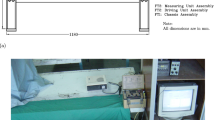The methods for low-cycle fatigue testing and cyclic crack growth testing of 10GN2MFA steel at 20 and 270°C are described. Based on test results, fatigue crack growth rate curves are plotted and the characteristics of low-cycle plastic deformation and fracture are found. A difference in the kinetics of low-cycle plastic deformation is shown – the cyclic softening at 20°C and hardening at 270°C – which has an influence on fatigue life and fatigue crack growth resistance of this steel. The last-mentioned characteristic has been studied using two test methods: (i) with a decreasing stress intensity factor range and (ii) with a constant magnitude of load.



Similar content being viewed by others
References
P. C. Paris and F. A. Erdogan, “A critical analysis of crack propagation laws,” J. Basic Eng., 85, No. 4, 528–533 (1963).
W. J. Plumbridge, “Review: Fatigue-crack propagation in metallic and polymeric materials,” J. Mater. Sci., 7, No. 8, 939–962 (1972).
K. Pandey and S. Chand, “An energy based fatigue crack growth model,” Int. J. Fatigue, 25, 771–778 (2003).
D. Kujawski and F. Ellyin, “A fatigue crack propagation model,” Eng. Fract. Mech., 20, 695–704 (1984).
G. Glinka, “A cumulative model of fatigue crack growth,” Int. J. Fatigue, 4, 59–67 (1982).
K. K. Shi, L. X. Cai, L. Chen, et al., “Prediction of fatigue crack growth based on low cycle fatigue properties,” Int. J. Fatigue, 61, 220–225 (2014).
P. J. Hurley and W. J. Evans, “A new method for predicting fatigue crack propagation rates,” Mater. Sci. Eng. A, 466, Nos. 1–2, 265–273 (2007).
S. K. Paul and S. Tarafder, “Cyclic plastic deformation response at fatigue crack tips,” Int. J. Pres. Ves. Pip., 101, 81–90 (2013).
K. K. Shi, L. X. Ca, C. Bao, et al., “Structural fatigue crack growth on a representative volume element under cyclic strain behavior,” Int. J. Fatigue, 74, 1–6 (2015).
J. Yang, W. Zhang, and Y. Liu, “Existence and insufficiency of the crack closure for fatigue crack growth analysis,” Int. J. Fatigue, 62, 144–153 (2014).
J. W. Hutchinson, “Singular behavior at the end of a tensile crack in a hardening material,” J. Mech. Phys. Solid., 16, 13–31 (1968).
J. Rice and G. Rosengren, “Plan strain deformation near a crack tip in a power-law hardening material,” J. Mech. Phys. Solid., 16, 1–12 (1968).
O. M. Herasymchuk, “Microstructure-dependent model for calculating the growth rate of physically small and long fatigue cracks,” Strength Mater., 47, No. 2, 257–267 (2015).
O. M. Herasymchuk and O. V. Kononuchenko, “Model for fatigue life prediction of titanium alloys. Part 1. Elaboration of a model of fatigue life prior to initiation of microstructurally short crack and a propagation model for physically short and long cracks,” Strength Mater., 45, No. 1, 44–55 (2013).
J. M. Barsom, “Fatigue-crack propagation in steels of various yield strengths,” J. Eng. Ind., 93, No. 4, 1190–1196 (1971).
V. F. Zelenskii, I. M. Neklyudov, L. S. Ozhigov, et al., “The use of microspecimens for inspection of mechanical properties and microstructural evolution of the base metal (10GN2MFA steel) of the main recycle piping of Unit No. 1 of Yuzhnoukrainsk Nuclear Power Station upon 100,000 running hours,” in: Proc. of the XIV Int. Conf. on Physics of Radiation-Induced Phenomena and Radiation Materials Science (June 12–17, 2000, Alushta–Kharkov) (2000), pp. 63–72.
A. P. Gopkalo and N. N. Teslyuk, “A device for the synchronization of cyclic heating with low-cycle mechanical loading,” Strength Mater., 33, No. 2, 183–187 (2001).
ASTM E647-15e1. Standard Test Method for Measurement of Fatigue Crack Growth Rates, ASTM International, West Conshohocken, PA (2015).
ISO 12108:2018. Metallic Materials – Fatigue Testing – Fatigue Crack Growth Method.
G. V. Tsyban’ov and A. I. Novikov, “Ultimate hardening/softening model of material for fatigue crack initiation onset and determination of its parameters,” Int. J. Fatigue, 39, 15–24 (2012).
Author information
Authors and Affiliations
Corresponding author
Additional information
Translated from Problemy Prochnosti, No. 1, pp. 56 – 63, March – April, 2020.
Rights and permissions
About this article
Cite this article
Tsybanev, G.V., Gopkalo, A.P., Kurash, Y.P. et al. A Study of Fatigue Crack Growth Rate in Steels in Relation to Crack-Tip Plastic Deformation and Fracture. Part 1. Test Methods and Results for 10GN2MFA Steel. Strength Mater 52, 228–234 (2020). https://doi.org/10.1007/s11223-020-00169-8
Received:
Published:
Issue Date:
DOI: https://doi.org/10.1007/s11223-020-00169-8




